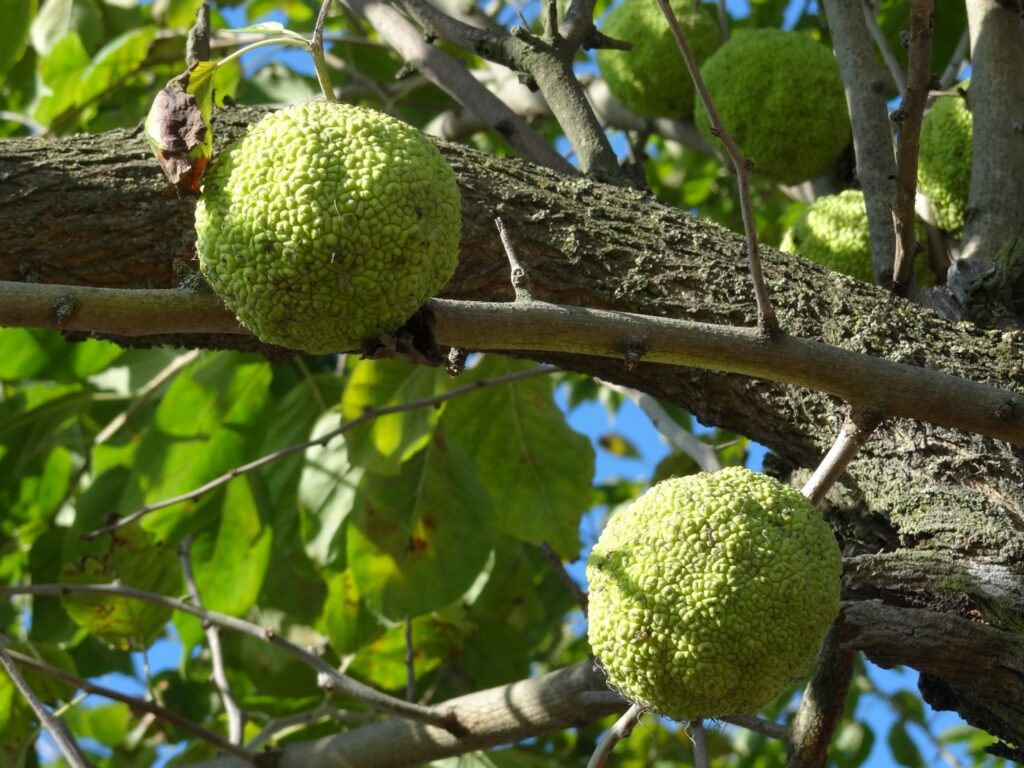By Lowell Wyse
I’m sitting in an old brick house in Tacoma, Washington, with Douglas firs, Himalayan blackberries, and an industrial port outside my window at the end of an overheated summer. But for some reason I’m thinking about Osage oranges.
When I first moved to a quiet agricultural town in central Kansas to attend college, I remember picking up these bright green “hedge apples” along the fencerow of the arboretum. Looking rather like alien softballs, these inedible fruits had a hard, brainy texture on the outside, sticky pith and dark seeds on the inside. I remember how local folks advised placing them along the foundations of houses to prevent spiders from getting inside.
A few years later, while in graduate school at Wichita State, I first read PrairyErth (1991), William Least Heat-Moon’s “deep map” of nearby Chase County, Kansas, which has a chapter all about the Osage orange tree. As the preferred species for creating thorny hedgerows on the Great Plains,Maclura pomifera played an outsize role in the colonization of the American West. Heat-Moon writes,
…as curbstones are to a suburb, so was Osage hedge to the prairies, as it came to mark out routes and channel citizens onto them, laying down a pattern that so shaped lives that people began to build their new houses in alignment with the now visible grid. They set out their furniture accordingly, dressers and bedsteads against walls running only in cardinal compass directions, so that, still today, Chase County sleeps north-south or east-west… (287).
Nineteenth-century settlers seized upon this species (whose native range was concentrated in what is now eastern Texas) as a natural technology – later supplanted by barbed wire – with which to convert the tallgrass prairie to corn fields and livestock paddocks, in service to the country’s new Jeffersonian geography.

Credit: Wikimedia Commons
I’m expecting environmental humanists to see right through this: The Osage orange is an obvious symbol of the dynamic border between nature and culture that we teach students to interrogate!
But I would like to take things even further and propose it as an image of both what I call ecospatiality – the inherent connectedness of nature, geography, and history – and an ecospatial approach to literature, the common ground between the academic fields of ecocriticism and geocriticism. Ecospatiality: A Place-Based Approach to Literature (University of Iowa Press, 2021) is an Osage orange of a book.
Reading PrairyErth as a graduate student is what first got me thinking about the mapping function of literature, which geocritics call literary cartography. Heat-Moon plays with map imagery a lot in that book, an exhaustive account of a seemingly nondescript place that uniquely captures some of the ways that nature, culture, and geography overlap. Because Heat-Moon’s archival “sense of place” differs categorically from how the term is sometimes deployed, I use his nonfiction travel writing to develop an understanding of place as the convergence of nature, space, and story. Then I proceed to analyze a series of 20th-century American novels – from Willa Cather’s Death Comes for the Archbishop to Richard Wright’s Native Son – with ecocriticism and geocriticism as the twin lenses in an ecospatial frame.
While “sense of place” often pops up in ecocritical discussions, I argue that we need a more nuanced version of it, one that accounts for the key contributions that geocriticism has made to literary studies in the past fifteen years, including insights from spatial theory, urban studies, and human geography. Bertrand Westphal’s Geocriticism (2011) and Robert Tally’s Spatiality (2012), two of the field’s foundational texts, offer ecocritics excellent insights on literature’s spatial aspects, how we interpret the world within the text.

Anyone who has ever planned a course or a unit around a particular place (e.g., San Francisco Novels) is already using a basic geocritical framework. This comparative literature impulse lies at the heart of Westphal’s conception of geocriticism, of which “multifocalization” (essentially, multiple perspectives on a place) is a founding principle. I deliberately adopt this technique in a chapter on Central New Mexico in Cather’s Death Comes for the Archbishop, Leslie Marmon Silko’s Ceremony, and Ana Castillo’s So Far from God, which resonate across their shared geography. Because of their commitment to place specificity – including toponyms like Rio Grande, Albuquerque, and Acoma – each of these novels offers a slightly different map of the same territory that comes together when we read like geocritics.
In some cases, as in John Steinbeck’s Salinas Valley fiction, the ecospatial sense of place is an essentially regional one that has much in common with the spatial imaginary of bioregionalism. Like toggling between map view and satellite view on Google Maps, thinking and reading ecospatially often means adopting a watershed perspective.
To the extent that so much work in ecocriticism and the environmental humanities begins in the living world and discusses how it relates to the world in the text, my approach in this book might not appear novel at all. Don’t we all use a “place-based approach” to some extent? What I hope this book offers, though, is a sense of how the tools of geocriticism can bolster the ecocritical method.
One of the most exciting findings is the way that place-specificity emerges as one of the keys to environmental justice literature and criticism. Simply put: real place names connect us to real environmental histories. While the ecological protest in So Far from God is impossible to miss, readers might be surprised to learn about the environmental elements of Richard Wright’s powerful critique in Native Son. By close-reading the novel’s many geographical markers (with Google Maps at the ready), I argue that Wright is effectively presenting housing segregation in 1930s Chicago as an environmental justice issue, all while using spatial metaphors to protest the systematic enclosure of Black people. Mapping Bigger Thomas’s travels in this provocative crime novel helps us better understand Wright’s argument: the environment made him do it.
It was on the opposite end of Chicago, the far North Side, where I developed most of these ideas during my doctoral studies at Loyola University Chicago. I’m especially grateful to Jack Kerkering, my dissertation director, for helping me map out the project, and to the incredible staff at the University of Iowa Press for seeing it through to print.
And to the ASLE community: Your work made this book possible. Thank you for being great friends and colleagues, for doing socially-engaged work that prioritizes people and places, and for modeling a slightly more humane version of academia. We need all of this right now.
 Lowell Wyse is a scholar of modern American literature and the environment with special interests in place, travel, and environmental justice. He holds a Ph.D. in English from Loyola University Chicago and a master’s in English from Wichita State University. From 2017–2021, he taught courses in writing, literature, and environmental humanities for Broward College (Florida) at the Center for Global Education in Lima, Peru. The author of Ecospatiality: A Place-Based Approach to American Literature (U Iowa P, 2021), Wyse also serves as Book Review Editor of the Steinbeck Review. Originally from the Maumee Watershed in Southern Michigan, Wyse now makes his home in Washington’s Puyallup Watershed, where he works as Assistant Director for the Tacoma Tree Foundation.
Lowell Wyse is a scholar of modern American literature and the environment with special interests in place, travel, and environmental justice. He holds a Ph.D. in English from Loyola University Chicago and a master’s in English from Wichita State University. From 2017–2021, he taught courses in writing, literature, and environmental humanities for Broward College (Florida) at the Center for Global Education in Lima, Peru. The author of Ecospatiality: A Place-Based Approach to American Literature (U Iowa P, 2021), Wyse also serves as Book Review Editor of the Steinbeck Review. Originally from the Maumee Watershed in Southern Michigan, Wyse now makes his home in Washington’s Puyallup Watershed, where he works as Assistant Director for the Tacoma Tree Foundation.
Website: LowellWyse.com
Twitter: @LowellDW
